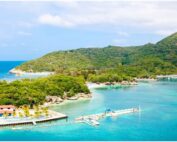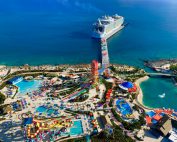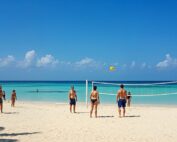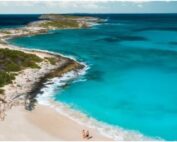TTC Special: Cruise tourism’s private islands
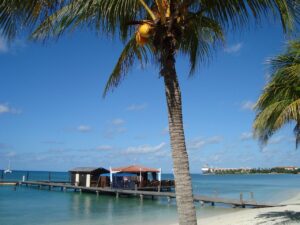
Cruise tourism’s private islands. Photo: Pixabay/chengtzf
By: José Luis Perelló Cabrera
The Caribbean Sea and its islands have become a main cruise area since the late 20th century. Its geographical structure allows short-distance navigation and visits to just over two dozen small island states and ports in its basin ― with a diversity of customs, languages and colonial roots ―, a veritable mosaic of cultures and nationalities.
Together with these tourist attractions, the region is presented as a safe destination, free of terrorism and war conflicts. The proximity of the Caribbean to the United States and its temperate climate have been important factors in the growth of this industry in the region.
By 2024, the Caribbean becomes the world’s most important cruise destination, with 45 percent global market share. Over the next five years, the incorporation of 72 new ships is expected, which will represent 244,000 new passenger capacities and an investment of 57.6 billion dollars.
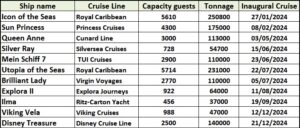
New cruises for 2024. TTC
Currently, cruise ships that operate in the Caribbean and its islands are considered destinations in themselves. This perception is reinforced with the comprehensive development of enclaves or Private Islands as tourist destinations operated by cruise lines, in response to the rapid growth in the number and size of ships, which exceeds the reception capacity and maneuverability of the majority of ports of call in the Caribbean.
In this sense, shipping companies have acquired uninhabited islands, most of them in the Bahamas due to their proximity to the Florida peninsula, and have created their own tourist destinations. Norwegian Cruise Line, Disney Cruise Line, Royal Caribbean or MSC Cruises are some of the companies that own those “little pieces of exotic land” where cruise passengers can enjoy an unforgettable stay, and which are promoted as the most exclusive places in the world.
Today the main cruise lines have private islands or exclusive enclaves in Caribbean ports. This innovative tourism product will continue to develop with the incorporation of surprising high-tech attractions, which will be the challenges that traditional Caribbean island destinations will have to face.
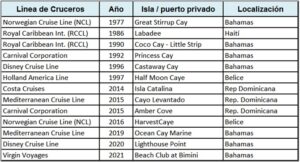
Private enclaves of Cruise companies in the Caribbean
The first cruise company featuring this experience was Norwegian Cruise Line (NCL), when in 1977 it purchased Great Stirrup Cay, a small island that is part of the Berry Islands in the Bahamas, developing a private destination for its cruise passengers. The northern part of the island has a white sand beach surrounded by rocks that provides an attractive diving area.
Among the most notable facilities is the inflatable 12-meter-hign toboggan, as well as diving to observe the “underwater sculpture garden” or explore a sunken ship; swim with rays and manta rays or rent the exclusive cabanas. It also has several gastronomic facilities, distributed across six beaches where you can practice many water sports and find children’s play areas and a market.
The carefully structured design of these experiences with private island allows passengers in most cases to be anywhere in the Caribbean that has tropical breezes, white sand beaches, warm clear waters and palm trees; in addition to a wide variety of consumption, distractions and moments of leisure, under a product model completely controlled by the company. Amenities and services on land are included in the payment for the trip, and any additional expenses can be made with a credit card issued by the cruise ship.
The companies have made strong financial investments in construction, logistics, leisure and recreation infrastructure; and they generally pay taxes for the usufruct of the land. But from a cruise company’s perspective, these islands not only meet the goal of providing passengers with an exclusive and safe place to enjoy a stay on land, but also keep the majority of expenses on the cruise ship.
In 1986, the Royal Caribbean International company inaugurated Labadee on the northern coast of Haiti, as a private tourist destination, exclusively for the customers of this shipping company’s cruises. Outstanding among the many offers at Labadee are the largest canopy in the Caribbean, which descends from a mountain at a speed of 90 kilometers per hour; the Dragon’s Tail Coaster; the large Dragon’s Splash Waterslide; the private luxury Beach Cabana at Nellie’s Beach cabanas; as well as a varied gastronomic and entertainment offer at Dragon Plaza, Barefoot Beach Club and Town Square.
Another Royal Caribbean private island, completely renovated in 2019, is Coco Cay Little Strip, in the Bahamas. It has one of the highest toboggans in the world, the 42-meter-high Daredevil’s Peak, leading to the Thrill Waterpark where the Wave Pool is located with the largest wave simulator in the Caribbean. Among its attractions, the magic of the private lagoon Coco Beach Club with Bora-Bora style cabanas also stands out; they are “over-the-water” bungalows built on stilts.
Among the most outstanding enclaves in the Bahamas include Castaway Cay is Disney Cruise Line’s 4-square-kilometer private island, mainly for families with children and teenagers in which host Mickey Mouse invites them to visit one of the ships used in the film Pirates of the Caribbean, the Observation Tower platform, the Pelican Plunge toboggan, among other amusements. This cruise line will soon open Lighthouse Point, through an agreement with the government of the Bahamas to exploit the southern area of the island of Eleuthera for 50 years.
As of 2014, the exclusive destinations of the shipping companies Costa Cruises, MSC Cruises and Carnival Corporation are located in the Dominican Republic. North of La Romana, Catalina Island, is an uninhabited territory constituted as a private tourist destination by Costa Cruises, where snorkeling and diving are offered, given the nature of its transparent waters and being surrounded by live corals in which colorful fish live.
Given these scenarios, luxurious ships and private islands that are exclusive for cruise users are a growing reality. It is a trend in recent years, which has been widely accepted by travelers who vacation on a cruise. The various cruise lines will continue to acquire islands for their exclusive use and management, providing an excellent service experience, both on the ship converted into a large luxury floating hotel, and on land with all the available attractions.

MORE NEWS



